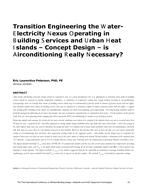
Transition Engineering the Water-Electricity Nexus Operating in Building Services and Urban Heat Islands – Concept Design – is Air Conditioning Really Necessary?
- Comments Off on Transition Engineering the Water-Electricity Nexus Operating in Building Services and Urban Heat Islands – Concept Design – is Air Conditioning Really Necessary?
- ASHRAE
Click here to purchase
After firstly determining if passive design cannot be expected to serve at a given development site, it is appropriate to determine what mode of building services would be expected to provide comfortable conditions, as ventilation or evaporative cooling may satisfy without resorting to air-conditioning. Consequently, there are broadly three modes of building services which may be recommended to provide coolth in summer if passive means will not suffice, and similarly another three modes of building services that may be required in to maintain comfort in winter if passive means will not suffice. I suggest that leading winter building service modes are humidification, moderate air-source heat pumping, and icing-heating. The icing-heating condition could be partially managed by defrosting of air-source heat pumps, but may recommend a ground-source or combustion heat-source. For the purposes of the present study there are seven operating modes ranging from direct expansion (DX) air-conditioning in summer to icy-heating in winter. Balancing comfort and economy, the criteria for the more extreme conditions were taken to be satisfied if the defined criteria are not to exceeded more than 10 days per year – inspired by the Australian approach to setting comfort design conditions with only daily min/max observations – where the average of the tenth highest daily max was used to determine the design dry bulb. So I propose that if mean daily conditions show that air-conditioning is desirable only nine days in a year, then it is not deemed necessary in that location. But if in that location there were at least ten days in a year where evaporative cooling or air-conditioning were desirable, then evaporative cooling would be the suggested system. And finally, passive design may be acceptable for comfort if there were less than ten days in-total in which any of the active modes of cooling were desired. Results include a tabulation of the medians from 157 countries. Larger federations such as USA, Canada, Russia, China, and Australia were not summarized as provincial climatic variability is vast. The highest drybulb threshold TVhot arises from ASHRAE 55 standard for comfort and the next two are the most common base temperatures of cooling and heating degree days, and Ticing is the upper whole degree associated with freezing up of air-source heatpumps together with ΔTice=5K of degrees that dewpoint is below drybulb. The highest wetbulb TVhumid is the author’s suggested limit for the suitability of ventilation to manage humidity without air- conditioning, and the lowest webbulb threshold Tdry is where the air may be too dry for comfort. The wetbulb Thumid is threshold of evaporative cooling.
Citation: 3rd Intl Conf: Efficient Bldg Design
Product Details
- Published:
- 2018
- Number of Pages:
- 9
- Units of Measure:
- Dual
- File Size:
- 1 file , 710 KB
- Product Code(s):
- D-ICEB18-C006

